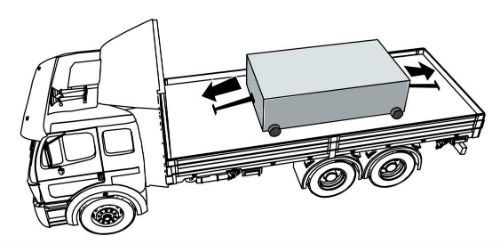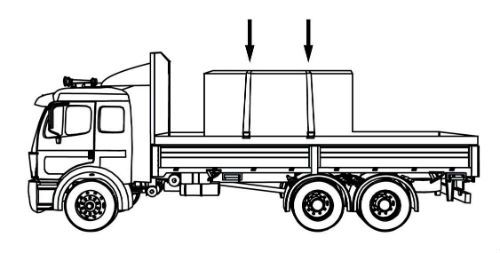CDL Practice Tests: Flatbed Cargo Securement
Choose A Section:
Go!What types of freight need to be secured properly?
- All freight should always be properly secured while driving.
- Intermodal containers.
- Hazardous materials.
- Equipment used for vehicle operation.
-
Any cargo and dangerous goods/hazardous materials, including:
- All general freight.
- All equipment carried for vehicle operation.
- Intermodal containers and their contents.
- Some specific commodities have additional or different securement requirements (see later sections of this Handbook).
- Additional requirements under separate regulations may also apply for transportation of certain types of dangerous goods or hazardous materials.
Cargo
What is the minimum weight of a shipment of paper rolls that would require specific securement requirements?
- 5,000 lbs
- 10,000 lbs
- 2,268 lbs
- It depends on how they're loaded
The rules in this section apply to shipments of paper rolls, which individually or together, weigh 2268 kg (5000 lb.) or more.
Note: Shipments of paper rolls that weigh less than 2268 kg (5000 lb.), and paper rolls that are unitized on a pallet may either be secured in accordance this section or with the general cargo securement requirements
The load carrying area of a truck, trailer, or intermodal container is referred to as the:
- Well
- Deck
- Headboard
- Bulkhead
Deck:
The load carrying area of a truck, trailer, or intermodal container.
If loading and securing paper rolls on a second layer:
- Make sure heavier rolls are on top.
- Stack the second layer at the back.
- Lay the second layer horizontally.
- Be sure the bottom layer extends to the front of the vehicle.
Stacked Loads
- Load paper rolls on a second layer only if the bottom layer extends to the front of the vehicle.
-
Prevent forward, rearward, or side-to-side movement:
- Either by the same means required for the bottom layer
- Or by the use of a blocking roll from a lower layer.
- A roll in the rearmost row of any layer must not be raised using dunnage.
As part of the log packing requirements:
- The center of the highest log on each side or end must be above the top of each stake, bunk, or standard.
- Each inside log on the side of a stack of logs must touch at least two bunks, bolsters, stakes, or standards.
- Logs must be loosely packed.
- Outer bottom logs must be in contact with and rest solidly against bunks, bolsters, stakes, or standards.
Packing requirements
- Logs must be solidly packed.
- Outer bottom logs must be in contact with and rest solidly against bunks, bolsters, stakes, or standards.
-
Each outside log on the side of a stack of logs must touch at least two bunks, bolsters, stakes, or standards. If one end of the log doesn't touch a stake:
- It must rest on other logs in a stable manner.
- It must extend beyond the stake, bunk, bolster, or standard.
- The center of the highest log on each side or end must be below the top of each stake, bunk, or standard.
Which of the following is not an acceptable method of containing loose parts when securing flattened or crushed vehicles?
- Sideboards or sides.
- Structural walls.
- Suitable covering material.
- Wedge them in between the flattened cars.
Containing Loose Parts
Use a containment system that:
- Prevents loose parts from falling from all four sides of the vehicle AND
- Extends to the full height of the cargo.
The containment system can consist of one or a combination of the following methods.
- Structural walls.
- Sides or sideboards.
- Suitable covering material.
The use of synthetic material for containment of loose parts is permitted.
All of these are requirements for securing longwood lengthwise except:
- Secure each log with at least two tiedowns if shorter logs are carried on top of the stack.
- Each outside log should bear against at least two stakes, one near each end of the log.
- Must be cradled in two or more bunks or contained by stakes.
- Each end of the log should extend at least 3 inches beyond the stakes.
Requirements for securing longwood loaded lengthwise
- Longwood must be cradled in two or more bunks or contained by stakes.
- Each outside log should bear against at least two stakes, one near each end of the log.
- Each end of the log should extend at least 0.15 m (6 in) beyond the stakes.
- If shorter logs are carried on top of the stack, secure each log with at least two tiedowns.
Methods to keep a cradle from sliding include:
- Placing a tiedown around the front of the cradle.
- Nailed wood blocking or cleats.
- Friction mats under the cradle.
- These can all be used.
Requirements for securing a single coil
Prevent the coil from rolling by supporting it:
- Timbers, chocks, or wedges held in place by coil bunks or similar devices to prevent them from coming loose.
- A cradle (for example, two hardwood timbers and two coil bunks) that is restrained from sliding by:
- Friction mats under the cradle.
- Nailed wood blocking or cleats.
- Placing a tiedown around the front of the cradle.
- The support must:
- Support the coil just above the deck.
- Not become unintentionally unfastened or loose in transit.
When loading paper rolls with eyes horizontal, which of the following is not a requirement for stacking a second layer:
- All the wells in the layer beneath must be filled
- It must be blocked against an eye-vertical blocking roll resting on the floor of the vehicle that is at least 1.5 times taller than the diameter of the roll being blocked.
- Place second layer with eyes vertical.
- The bottom layer must extend all the way to the front.
Requirements for eyes crosswise: secure stacks of paper rolls from front-to-back movement
- Do not load paper rolls on a second layer unless the bottom layer extends to the front of the vehicle.
- Load paper rolls on higher layers only if all wells in the layer beneath are filled.
-
Secure the foremost roll in each upper layer (or any roll with an empty well in front of it) against forward movement:
- Either by placing it in a well formed by two rolls on the lower row whose diameter is equal to or greater than that of the roll on the upper row.
- Or by banding it to other rolls.
- Or by blocking it against an eye-vertical blocking roll resting on the floor of the vehicle that is at least 1.5 times taller than the diameter of the roll being blocked.
What is the minimum aggregate WLL of all tiedowns in a group of concrete pipe?
- 5,000 lbs.
- 80% of the total weight of all pipes in the group.
- More than 50% of the total weight of all pipes in the group.
- It depends on the size of the pipe.
General tiedown requirements
The aggregate working load limit of all tiedowns on any group of pipe must be more than half the total weight of all pipes in the group.
About The Flatbed Cargo Securement CDL Manual
Studying the flatbed cargo securement CDL manual is not a requirement for getting your CDL permit or license. It is required knowledge for flatbed drivers.
Some questions you should be able to answer for flatbed cargo securement:
- What is the minimum Working Load Limit of a tiedown used to secure logs?
- What is the minimum weight of a shipment of paper rolls that would require specific securement requirements?
- When securing concrete pipe over 45 inches loaded crosswise, which direction must the tiedowns on the front half of the load run?
- What is a cab shield?
- When securing concrete pipe over 45 inches loaded crosswise, which direction must the tiedowns on the rear half of the load run?
- What is a dunnage bag?
- Who is responsible for inspecting securing devices and cargo within the first 50 miles?
- How many tiedowns are required on a stack of shortwood loaded crosswise?
- What is the minimum working load limit of each tiedown used to secure crushed or flattened vehicles?
- Define 'bolster'
- What is a hook-lift container?
- When a tiedown is attached directly to the cargo, what is the ideal angle where it attached to the vehicle?
What is a securing device?
Any device specifically manufactured to attach or secure cargo to a vehicle or trailer:
- Synthetic Webbing
- Chain
- Wire rope
- Manila rope
- Synthetic rope
- Steel strapping
- Clamps and latches
- Blocking
- Front-end structure
- Grab hooks
- Binders
- Shackles
- Winches
- Stake pockets
- D-rings
- Webbing ratchet
- Bracing
- Friction mat
What is a tiedown?
A combination of securing devices that forms an assembly that:
- Attaches cargo to, or restrains cargo on a vehicle.
- Is attached to anchor point(s).

Some tiedowns are attached to the cargo and provide direct resistance to restrain the cargo from movement.

Some tie-downs pass over or through the cargo. They create a downward force that increases the effect of friction between the cargo and the deck. This friction restrains the cargo.
 Related Cargo Securement Terms That Every Driver Should Know:
Related Cargo Securement Terms That Every Driver Should Know:
-
Tiedown:
A combination of securing devices which form an assembly that attaches cargo to, or restrains cargo on, a vehicle or trailer, and is attached to anchor point(s).
-
Contained:
Cargo is contained if it fills a sided vehicle, and every article is in contact with or sufficiently close to a wall or other articles so that it cannot shift or tip if those other articles are also unable to shift or tip.
-
Blocking:
A structure, device, or another substantial article placed against or around an article to prevent horizontal movement of the article.
How should tiedowns be attached?
Tiedowns can be used in two ways:
-
Attached to the cargo:
- Tiedowns attached to the vehicle and attached to the cargo.
- Tiedowns attached to the vehicle, pass through or aroundan article of cargo, and then are attached to the vehicle again.
-
Pass over the cargo:
- Tiedowns attached to the vehicle, passed over the cargo, and then attached to the vehicle again.
Tiedown placement:

Place the tiedown as close as possible to the spacer.
Position the tiedowns as symetrically as possible over the length of the article.

Position the tiedowns to preserve the integrity of the article.







 TT On Facebook
TT On Facebook